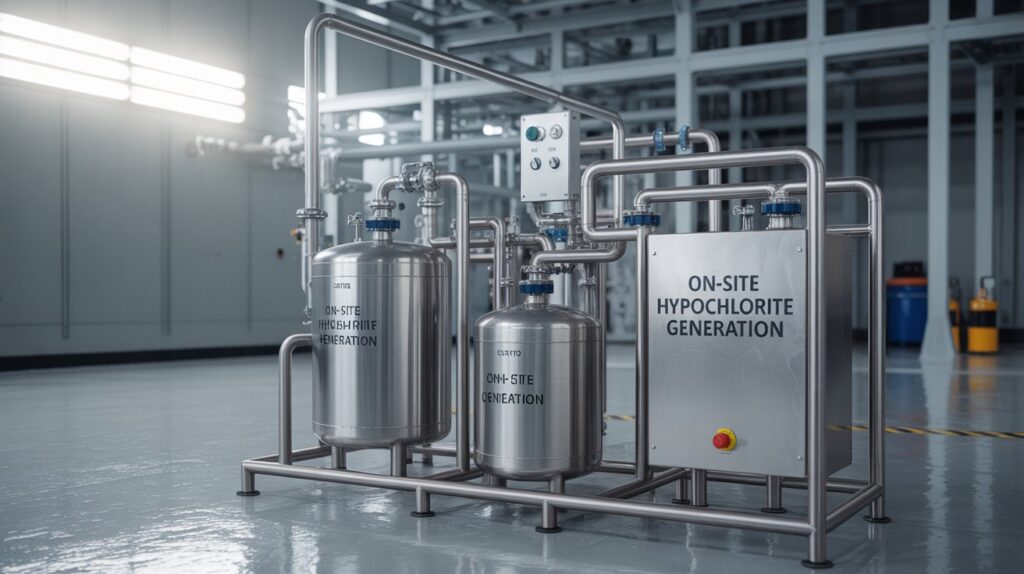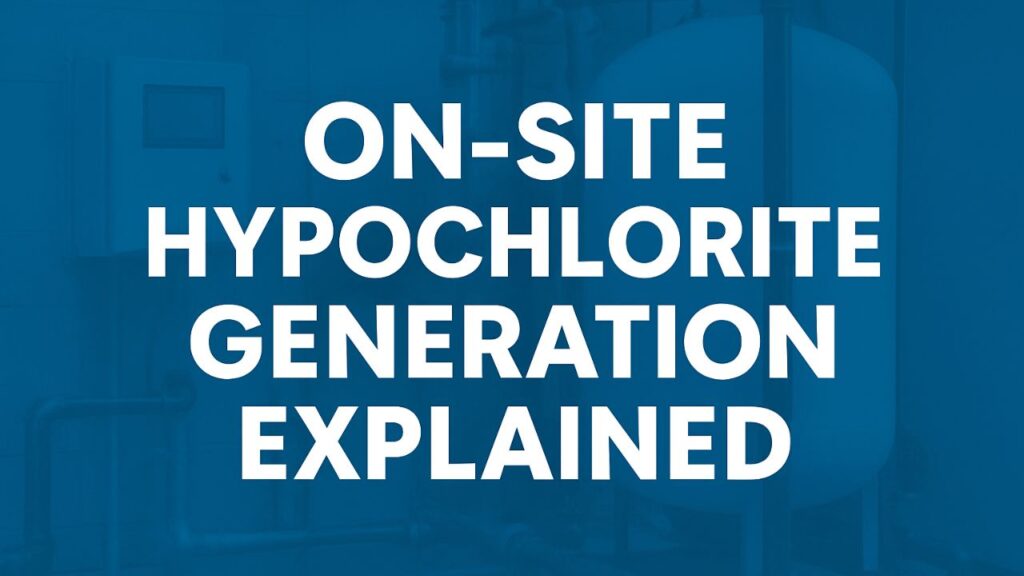Sodium hypochlorite generators are devices that produce sodium hypochlorite, a chemical compound commonly used as a disinfectant and bleaching agent. These generators work by using salt, water, and electricity to produce a solution of sodium hypochlorite, which can then be used to disinfect water in various applications such as swimming pools, drinking water treatment, and wastewater treatment. The process of generating sodium hypochlorite involves the electrolysis of a salt solution, which produces chlorine gas that is then dissolved in water to form sodium hypochlorite. This method of producing sodium hypochlorite on-site offers several advantages over traditional methods of chlorine production, including cost savings, reduced environmental impact, and improved safety.
Sodium hypochlorite generators come in various sizes and capacities, ranging from small-scale units for residential use to large-scale systems for industrial applications. These generators are designed to be easy to operate and maintain, making them a convenient and cost-effective solution for water purification. By understanding the principles behind sodium hypochlorite generation and the factors that influence its performance, water treatment professionals can make informed decisions about the implementation of these systems in their facilities.
Advantages of Using Sodium Hypochlorite Generators in Water Purification
There are several advantages to using sodium hypochlorite generators for water purification. One of the main benefits is the on-site production of sodium hypochlorite, which eliminates the need to transport and store large quantities of chlorine gas or liquid bleach. This not only reduces the risk of accidents and spills but also lowers the overall cost of disinfection. Additionally, sodium hypochlorite generators offer greater control over the concentration of the disinfectant, allowing for more precise dosing and improved disinfection efficiency.
Another advantage of sodium hypochlorite generators is their environmental friendliness. Unlike traditional chlorine production methods, which can release harmful by-products into the environment, sodium hypochlorite generation produces minimal waste and has a lower environmental impact. This makes it a more sustainable option for water treatment facilities looking to reduce their carbon footprint and comply with environmental regulations. Furthermore, the use of sodium hypochlorite as a disinfectant has been shown to be effective against a wide range of pathogens, making it a reliable choice for ensuring the safety and quality of treated water.
Considerations for Implementing Sodium Hypochlorite Generators
When considering the implementation of sodium hypochlorite generators in water purification systems, there are several factors that need to be taken into account. One important consideration is the quality of the salt used in the generation process, as impurities in the salt can affect the performance and longevity of the generator. It is essential to use high-quality salt that meets the specifications recommended by the generator manufacturer to ensure optimal operation and minimize maintenance requirements.
Another consideration is the design and capacity of the sodium hypochlorite generator, which should be selected based on the specific needs and demands of the water treatment facility. Factors such as flow rate, water quality, and disinfection requirements will influence the size and configuration of the generator, so it is important to conduct a thorough assessment of these parameters before making a decision. Additionally, proper installation and integration of the generator into the existing water treatment infrastructure are crucial for ensuring its seamless operation and compatibility with other treatment processes.
Maintenance and Care of Sodium Hypochlorite Generators
Proper maintenance and care are essential for ensuring the reliable performance and longevity of sodium hypochlorite generators. Regular maintenance tasks include cleaning and inspecting the generator components, checking for leaks or corrosion, and calibrating the system to maintain accurate dosing levels. It is also important to monitor the quality of the salt used in the generation process and replace it as needed to prevent buildup and clogging in the generator.
In addition to routine maintenance, proper care of the generator involves following safety protocols and guidelines for handling chemicals and operating electrical equipment. This includes wearing appropriate personal protective equipment, such as gloves and goggles, when handling sodium hypochlorite or working with the generator. It is also important to have a comprehensive understanding of the generator’s operation and emergency procedures in case of malfunctions or accidents. By prioritizing maintenance and care, water treatment professionals can ensure that their sodium hypochlorite generators operate efficiently and safely.

Safety Precautions When Using Sodium Hypochlorite Generators
Safety is a top priority when using sodium hypochlorite generators for water purification. As with any chemical handling process, it is essential to follow strict safety precautions to prevent accidents and exposure to hazardous substances. This includes providing adequate ventilation in areas where sodium hypochlorite is being generated or used, as well as implementing measures to contain spills and leaks. It is also important to have emergency response protocols in place, such as eyewash stations and spill containment kits, to address any incidents that may occur.
Furthermore, proper training and education for personnel involved in operating sodium hypochlorite generators are crucial for ensuring safe practices and minimizing risks. This includes training on handling chemicals, operating equipment, and responding to emergencies, as well as regular refresher courses to reinforce safety protocols. By promoting a culture of safety and accountability, water treatment facilities can create a secure environment for using sodium hypochlorite generators and protect their employees from potential hazards.
Case Studies of Successful Implementation of Sodium Hypochlorite Generators
There are numerous case studies that demonstrate the successful implementation of sodium hypochlorite generators in various water purification applications. For example, a municipal water treatment plant in California installed a sodium hypochlorite generator to replace its aging chlorine gas system, resulting in improved disinfection performance and reduced operating costs. The on-site generation of sodium hypochlorite allowed the plant to eliminate the need for chlorine gas storage and transportation, enhancing safety and compliance with regulatory requirements.
In another case study, a commercial swimming pool facility in Florida implemented a small-scale sodium hypochlorite generator to maintain water quality and sanitation for its patrons. The generator provided a convenient and cost-effective solution for producing chlorine on-site, eliminating the need for frequent deliveries of liquid bleach and reducing overall maintenance requirements. These case studies highlight the versatility and effectiveness of sodium hypochlorite generators in diverse water treatment settings, demonstrating their potential for addressing specific challenges and achieving operational goals.
Future Innovations and Potential of Sodium Hypochlorite Generators in Water Purification
Looking ahead, there is significant potential for future innovations in sodium hypochlorite generators and their applications in water purification. Advancements in technology and materials may lead to more efficient and compact generator designs, as well as improved automation and control systems for optimizing performance. Additionally, research into alternative methods for generating sodium hypochlorite, such as membrane electrolysis or electrochemical activation, could offer new opportunities for enhancing the sustainability and cost-effectiveness of this disinfection process.
Furthermore, the potential for integrating sodium hypochlorite generators with other water treatment technologies, such as membrane filtration or UV disinfection, presents exciting possibilities for creating comprehensive and integrated treatment solutions. By combining different disinfection methods with on-site generation of sodium hypochlorite, water treatment facilities can achieve higher levels of water quality and public health protection while minimizing operational complexities. As these innovations continue to evolve, sodium hypochlorite generators are poised to play an increasingly important role in advancing the efficiency and sustainability of water purification processes around the world.
